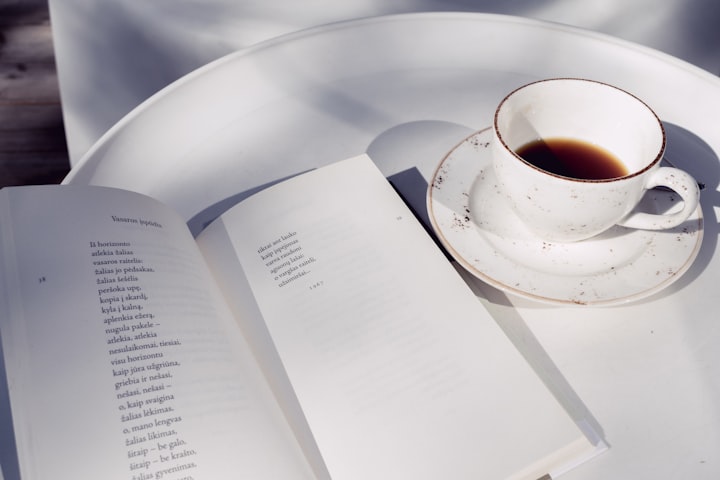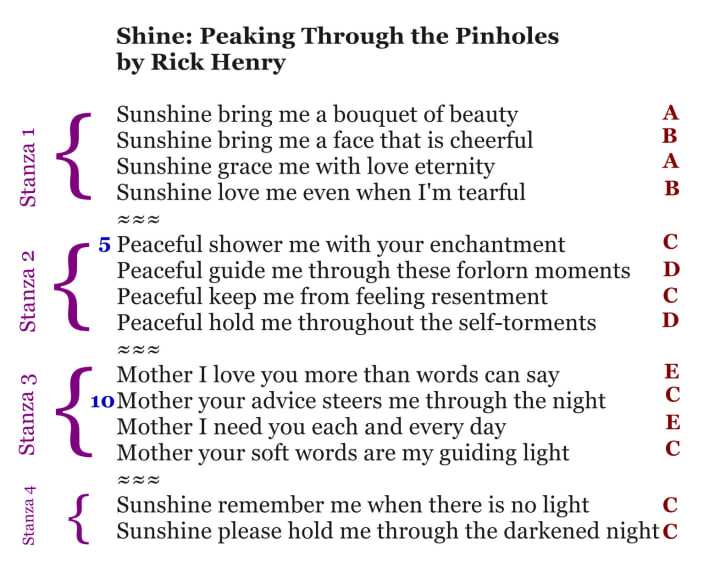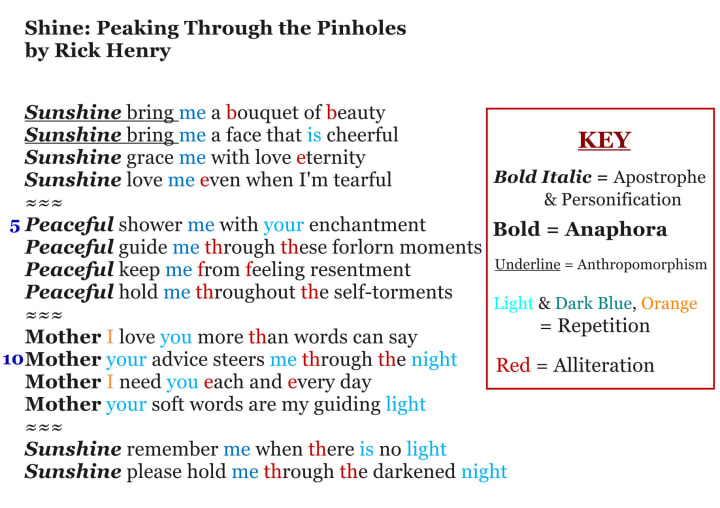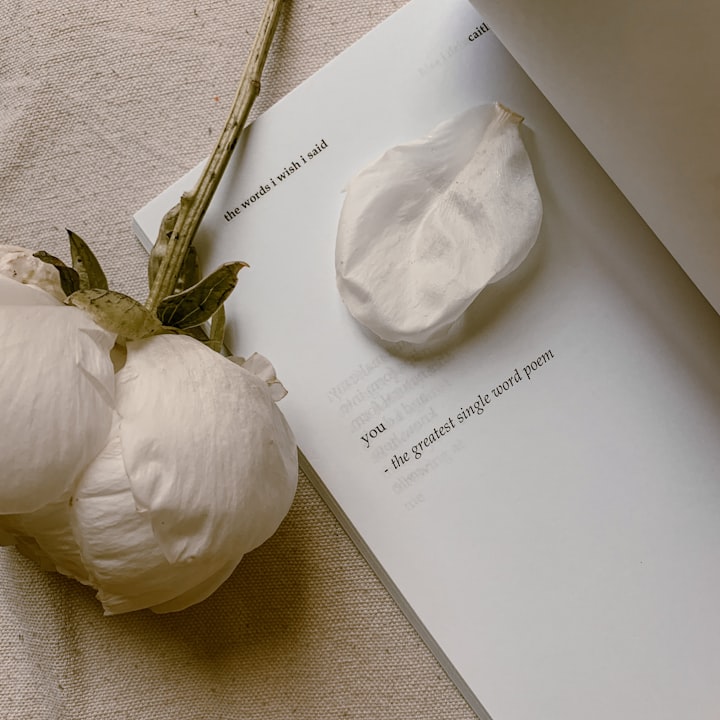Introduction To Annotating And Analyzing Poems
Repetition, Anaphora, Alliteration, Apostrophe, Euphony

Welcome to the third article in the series of learning how to annotate and analyze poetry. If you stumbled across this article first, you can scroll below to read the first and second articles that helped get us to this point.
We are going to jump right into the review since the basics were already covered in the first two articles. The objective now is to put everything we learned so far into practice while adding new literary and poetic devices along the way.
For all examples, I use modern poems to show literary and poetic devices in action. This means a fresh, contemporary poem by an artist you can support, follow and interact with now!
A Review Of Stanzas, Line Numbers And Rhyme Scheme
It is time to apply what we learned from the first and second articles. We are going to determine the stanzas, line numbers and rhyme scheme of a poem instead of a haiku for today’s practice and review.
Our poem for today’s lesson is “Shine” by Rick Henry.

- Number of stanzas = 4
- Number of lines = 14
- Rhyme scheme = ABAB, CDCD, ECEC, CC
As a reminder, rhyme scheme can be argued. Sometimes students and teachers come up with a different rhyme scheme based on how he or she pronounces a word. Sometimes the rhyme scheme might be listed differently based on if the person analyzing it included sight or near rhyme or not.
Review of Annotations for Literary and Poetic Devices
Whenever you annotate a poem, it is important to create and provide a Key or Legend for your markings and notations. As you will see in “Shine”, there are a lot of devices that just one word can be used for.
An example of multiple uses for one word in the poem “Shine” is the word “Sunshine.” I annotated Anthropomorphism in this poem to not only review the term, but also to show the difference to a close relative of Anthropomorphism called Personification. You will learn a little about Personification below, and more in a future article.
To review, Anthropomorphism is when a writer gives human attributes to an inanimate object or non-human entity (think Beauty and the Beast). The word “Sunshine” has two more devices it is associated with, Apostrophe and Anaphora (which will also be discussed below). That’s four devices that just one word, “Sunshine”, can be used for!

New Literary and Poetic Devices
Today we have five new literary/poetic devices.
Repetition is the use of a sound, letters, words or phrases two times or more in a written work to heighten the mood or emphasis of an idea. In “Shine”, there is a lot of repetition. There is so much in fact that it covers several types of Repetition, including Anaphora and Alliteration. Examples of basic Repetition in the poem includes the frequent use of certain words, like “me,” “you” and “I”.
If I were to discuss this Repetition in an essay, I could make an argument that perhaps the use of the personal pronouns—"me,” “you” and “I”—occurs in order to emphasize the intimate nature of the poem.
Anaphora is the repetition of a word at the beginning of two or more lines of poetry, usually in a row. “Shine” makes use of Anaphora in all four stanzas. First with the word “Sunshine”. Second with the word “Peaceful”. Third with the word “Mother.” Fourth with the word “Sunshine” again.
If I were to discuss Anaphora in an essay, I might only focus on the repetition of “Sunshine” since it is unique in that this word is used in the first and fourth stanzas. The question might be, “Why did Rick Henry circle back to this word specifically? Or, Why is it only used twice the second time around?
Alliteration is the repetition of the same letter or sound at the beginning of words right next to each other or in close proximity. Here I highlighted the letters “b”, “f” and “e” and the combination sound of “th”. To discuss a possible analysis of these alliterations, skip down to Euphony below.
Apostrophe is a direct address to an absent person or personification as if he, she or it were there in person. For this poem, highlighting the apostrophes also makes another literary/poetic device stick out. That device is Personification. But that’s not the focus of today. However, last time we learned about Anthropomorphism (which is present in this poem too) and Personification is like a sibling to Anthropomorphism.
So where do we see Apostrophe in “Shine”? The words “sunshine” and “peaceful” are very clear Apostrophes. This is evident because these words are Personified and Anthropomorphized. “Sunshine” and “Peaceful” become replacement words for “Mother” and are asked to do certain things as if they were human. While I would like to add the word “Mother” to the list of Apostrophes, I’m not because it is unclear if in that section of the poem the Mother is being spoken to directly or not. But the fun part is this could be the basis for an essay!
Euphony is the use of pleasing and harmonious sounds (usually long vowel sounds) and words that help create a sense of serenity and delight. In my annotations of “Shine”, you do not see a specific symbol, color or marking used to highlight where it occurs. This is because Euphony is created from a combination of factors.
In “Shine” the focus on softer sounding vowels and consonants helps boost the mood and relationship to words like “sunshine”, “mother” and “peaceful.” Even those three words alone can evoke a feeling of serenity or happiness for most people.
What We Learned Today
Once again, we covered a lot! We reviewed stanzas, line numbers and rhyme scheme. Today we added new ways to annotate a poem. Before I used a combination of objects like circles, rectangles and stars to note interesting finds in poems. Today I used bold, italics, underlines and colors. This showed that there were many devices that could be applied to the same word or phrasing. That’s why having a Key or Legend is helpful.
We also learned the definition and use of five new literary/poetic devices: Repetition, Anaphora, Alliteration, Apostrophe and Euphony. Our annotations help us see patterns in poems. These patterns, or lack thereof, help us have the information and examples needed to write a whole essay…or at least carry out a great discussion.
Did You Miss The First and Second Articles In This Series?
Read them here:
Read The Original Poem Here:
Permissions: The author received the consent and blessing of Rick Henry to use his poem “Shine”. This is a contemporary poem published by a writer on Vocal. That means a recently published poem by an artist you can support, follow and interact with now!
About the Author
Stephanie Bradberry is first and foremost an educator and life-long learner. Her time in academia spans 19 years and counting as a professor of English, Literature, Business and Education, former high school English teacher, and more. She loves freelance writing and editing. She is the founder/owner of Stephanie J. Bradberry LLC and former founder/owner of Crosby Educational Consulting, LLC. Learn more at stephaniebradberry.com
About the Creator
Stephanie J. Bradberry
I have a passion for literature and anime. And I love everything involving academia, health, metaphysics and entrepreneurship.
For products and services, visit: stephaniebradberry.com
For online courses, visit: bradberryacademy.com
Reader insights
Outstanding
Excellent work. Looking forward to reading more!
Top insights
On-point and relevant
Writing reflected the title & theme
Easy to read and follow
Well-structured & engaging content
Masterful proofreading
Zero grammar & spelling mistakes
Compelling and original writing
Creative use of language & vocab
Expert insights and opinions
Arguments were carefully researched and presented
Eye opening
Niche topic & fresh perspectives
Excellent storytelling
Original narrative & well developed characters
Heartfelt and relatable
The story invoked strong personal emotions






Comments (7)
For someone like me who wants to understand and write poetry these articles are excellent.
Nicely done. I'm learning so much from these articles. Thank you.
Wow! I am learning so much from you. Take my subscription so I can learn more :)
Great Job Stephanie. I enjoyed reading this and learned a few things I will apply in my next poetry writing. By the way I used sunshine only twice the second time around because the poem was written in the form of a Sonnet.
Wowww, this was amazing! Very insightful and informative explanation on everything! It was just so fascinating! I enjoyed reading this!
Another fantastic article from you!! You make it seem so easy. Thank you for sharing your expertise :)
Thank you! These articles are so informative & helpful! :)